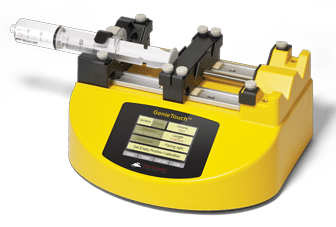Commercial laboratory pumps cost quite a lot – I know I have had to buy several for testing SyringePumpPro. I think there are about 12 pumps here.
Your opinion on whether they cost too much is probably strongly determined by:
- your pumping requirements – a very simple on/off or a flow waveform of some kind,
- your experience with commercial pumps, if you have experience with a commercial grade pump you probably enjoyed using it, (you didn’t? – tell me about it)
- what you have to offer in terms of skills (electronic and mechanical) to support your use of a DIY pump,
- what you have to loose if the pump fails or delivers poor pumping results,
- another big factor is the number of pumps your application requires.
If you could DIY a pump that gave you the resolution – in terms of flow control, and the reliability to work every time, meeting your fluid pumping needs – you could save quite a bit of money.
Resolution means being able to pump at the correct rate AND pump evenly at the correct rate over time. The greatest enemy here is any mechanical binding, or pulsations in the motor drive system. That said, there are going to be many applications where a certain amount of variation in the pumping rate is tolerable.
Remembering that reliability and repeatability are MAJOR factors in a syringe pump. It matters what happens when the pump fails. If a pump fails in the middle of a task – it may lead to a lost experimental result – and that’s a real time waster, but what about the costs of the consumables? This can add up. If your experimental setup is based on an unpredictable fluid flow, perhaps the quality of your experimental results might be questioned.
Aquarium Fish – a simple pumping example
For example take the simple scenario of a pump dosing an tropical fish tank with fertilizer each day. This produces lush plant growth. The fertilizer solution is very expensive.
- If the pump fails in a way that the fertilizer is simply not applied to the aquarium, then the plants don’t grow so well. It takes time to notice this – but the cost is probably not that great.
- If the pump fails in a way the the fertilizer is over-dosed, soon the aquarium will become a smelly algae soup and the expensive exotic plants and fish may all be lost. Costly consequences.
- If the pump fails in a way that the fertilizer containment is lost – then you get no fertilization and an expensive loss of a lot of this fertilizer.
- If the pump fails in a way that all fertilizer is dumped into the tank, there’s potential for a loss of those expensive plants and fish – possibly very quickly. These things happen in the middle of the night – that’s experience talking!
So, there’s a reason commercial pumps cost what they do – they need to use quality components to get the resolution and reliability needed. So I would say they are worth the cost.
DIY Syringe Pump Is A Possibility
I believe that for some applications a well thought out and implemented DIY syringe pump will be possible.
Typically DIY syringe pumps component cost comes to something like $200. Then you need to spend time building, testing. An NE-500 is $500 and it arrives in a couple of days and will work reliably, repeatably, accurately and provide so many other features that the DIY community have yet to create. In time they will create them – but you have fluid flow needs today – right?
Have you built a DIY Syringe Pump?
If you have – whether it be micro-controller (ASCII/rs232) controlled, PLC controlled or not – please send me a link to your design.
Related Pages
Make Your Own Pump – What Skills and Challenges?


